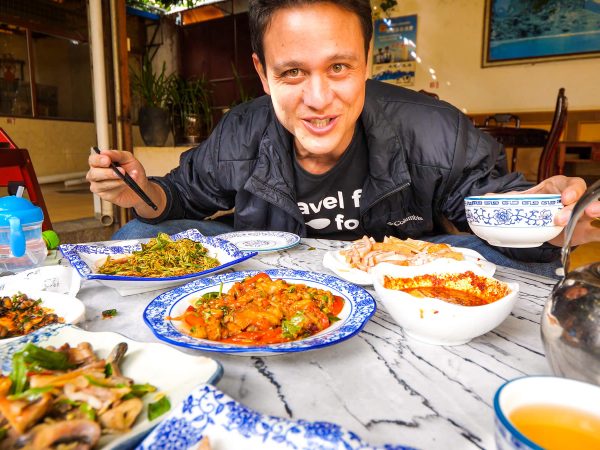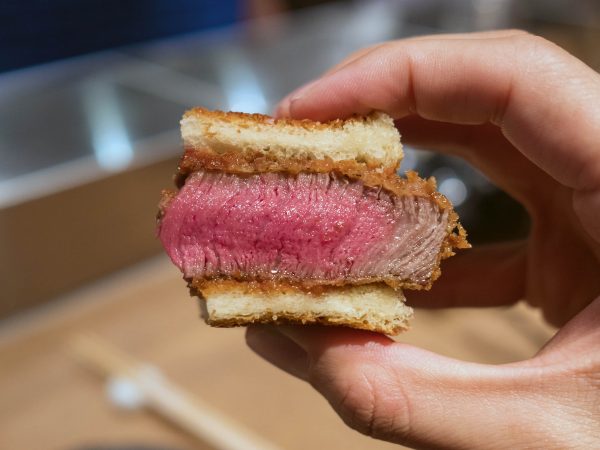
Uzbekistan in Central Asia is home to an enchanting land of Silk Road history, massive portions of food, and a heart-warming culture of hospitality.
I had the privilege to travel to Uzbekistan with the Ministry of Tourism (thank you Bekruz!), learning about their immense history, and experiencing Uzbek food and culture to the fullest.
I’m going to share the highlights with you right now. You can also watch the entire series on video here.

Tashkent, Uzbekistan
NOTE: This does not include every meal and detail about my trip to Uzbekistan, but it’s the main highlights, the top food and experiences I had during my trip.
From Bangkok we flew to Tashkent, the capital and largest city of Uzbekistan. Tashkent is an ex-Soviet city in Central Asia with a history of destruction and re-building multiple times, from both foreign conquerors and earthquakes.
I was immediately surprised how clean, green, and spacious Tashkent is.
During our time in Tashkent, we stayed at Wyndham Tashkent hotel, a nice base, and their breakfast was amazing.

Chorsu Bazaar
Chorsu Bazaar, the massive traditional Uzbek market, is one of the best places to immerse yourself into the culture of Tashkent.
It’s a feast for the eyes of fresh meat, spices, fruits and vegetables, and everything else produced in Uzbekistan.
The dome structure of the market is iconic, and reminds me of a stock exchange floor, a museum of a market.

In the food court section of Chorsu Bazaar you’ll find an array of ready-made food to consume.
The lady in this photo has been making these dumplings for over 25 years. She uses a noodle like wrapper, stuffs them with thinly julienne potato, then smothers them in tart tomato sauce.

Plov Center
Plov (pilau) is the most beloved food of Uzbekistan, a combination of rice, meat, usually carrots, oil, and seasonings.
Every city in Uzbekistan has their own version, and as Bekruz told me, in Uzbekistan, “plov is love.”
In Tashkent, the place to go for plov is the Plov Center, an opera house like restaurant that prepares 1,500 Kilos of plov per day… and sells out in a couple hours!

A delicacy in Tashkent
Naryn is a popular dish in Tashkent. Made with very thin slices of uncooked dough, its then hand-mixed with minced meat. Also including spices like cumin and pepper, its finally topped by a couple slices of qazi, horse meat sausage.
I thought it was one of the more unique dishes of Uzbekistan.

Full of History
Tashkent is an amazing city to walk around, so green and clean, with huge wide open spaces and sidewalks.
One of the landmarks is the statue of Amir Temur, one of the greatest conquerors of Central Asia.
Behind, the iconic Hotel Uzbekistan, a remnant of Soviet architecture.

Uzbek Somsa
I don’t think I went a single day, during my entire trip to Uzbekistan, without eating at least one or a few somsa (or samosa).
This pocket of dough filled with mutton and spices is the most common snack or light meal in Uzbekistan and across Central Asia.
Get exclusive updates
Enter your email and I’ll send you the best travel food content.
Known for their teardrop shape as they droop into the tandoor oven, Somsa Minor was the best I tried.

Uzbek Choyhona
In Uzbekistan a Choyhona is a part of the social and hospitable culture.
It’s not a restaurant, but you bring your own food (they do have cooks there too). It’s a time to socialize with peers, talk about serious issues, and feast on usually quite manly foods.
It was an honor to be invited to a Choyhona, a feast spreading across the table. The main dish was an entire oxtail, stewed in its own fat. It was one of the most memorable Uzbekistan travel and cultural experiences I had during my trip. Thank you to Baha and Rashad for organizing it.

Chinoz Fish Market
The journey continued, and from Tashkent we drove to Samarkand. It’s about a 4 hour drive if you don’t make 4 food stops like we did.
Along the way, we stopped at Chinoz Fish Market, a series of freshwater fish restaurants known by fish lovers throughout Uzbekistan.

The carp was chopped into pieces and deep fried.
Then, in a cooking move I’ve never seen anywhere else in the world (wait till you see the video, coming soon), right out of the hot oil, she sprinkles it with garlic water as it hissed. Finally a handful of dill and cilantro make this dish complete.

Sweetest melons in the world
Many varieties of melons originate in Central Asia, and Uzbekistan is known to have some of the sweetest melons in the world.
In-between Tashkent and Samarkand you’ll see melon markets on the side of the road, and not stopping to slurp down some melon would be horrible.

Next stop on the road trip: somsa.
I had the chance to pluck my first somsa from a tandoor oven. That was fun, and actually harder than it looks to get it out of the oven nice and clean. They really stick to the hot clay oven walls!

Samarkand, Uzbekistan
Continuing the Uzbekistan travel guide highlights, we arrived in Samarkand – an ancient city with some of the grandest historical sites in the country.
This is where the magnitude of history starts to hit you, a city that was conquered by both Alexander the Great and Genghis Khan.
We stayed at the DiliMah Premium Luxury pink and purple plush hotel, music was a little loud at night, but overall ok.
Check out my Samarkand guide here.

Registan
Registan is the ancient section of Samarkand, a courtyard of Islamic schools and Mosques, once a site of trade and bazaars along the Silk Road.
The outside is spectacular, but step inside and the detail and preservation will blow your mind.

Samarkand plov
In addition to history, Samarkand also had some of my favorite food in all of Uzbekistan.
Again, you can’t go to a city in Uzbekistan and not try their version of plov, and Samarkand had my personal favorite version – braised in flax-seed oil, a layer of caramelized carrots, and sprinkled with tender meat.

At Osh Markazi restaurant, they served us on a massive communal platter, and it was one of the greatest Uzbek food moments of my trip.
When you travel in Uzbekistan you don’t want to miss Samarkand plov.

Uzbek kebabs
Let’s not forget the meat… in Uzbekistan you will eat a lot of meat – mutton and beef are the two most common.
He’d been the boss of the grill at Ikrom Shashlik for over 20 years, and though without a hint of a smile, his mastery of grilling shines.

Without a doubt, they were the best kebabs I had in Uzbekistan.
Notice the kebab on the far left, thin slices of alternating mutton meat and fat, grilled to perfect umami smokey juiciness.

Shah-i-Zinda
Shah-i-Zinda, a series of mausoleums decorated in an incredible mosaic of turquoise, is one of the most spectacular sites in Samarkand.
Not to be missed.

Bukhara, Uzbekistan
From Samarkand we continued our travel through Uzbekistan, driving to Bukhara. It was about a 5 – 6 hour drive.
Bukhara is an ancient city of World Heritage, and was a hugely influential trade point along the Silk Road.
The entire center of the old city is filled with ancient buildings, mosques, madrassas, and bazaars.

Huge turquoise domes glisten in the sunshine and dominate the skyline of Bukhara.
It truly is a special and very memorable sight to behold.

Easily the most impressive site in Bukhara to me though, was the Kalyan minaret. It reaches 48 meters high, and was built in 1127.
It’s spectacular, and even Genghis Khan spared it from destruction.

Bazaar in Bukhara
For breakfast in Bukhara we headed to the bazaar, a sprawling market with a section for everything.
A friendly couple of ladies invited us to eat at their stall (it wasn’t actually a restaurant, they just had a table for themselves in the back), where we dug into rounds of fresh bread and kaymak, thick and creamy clotted cream.

Tandoori lamb
All the food was wonderful, but perhaps the culinary highlight of Bukhara was the tandoori lamb experience at Chor Bakr.
They pull it out of the blazing tandoor oven, lamb meat barely still clinging to the bone. It was so tender you could grabs chunks of meat by the fistful.

The lamb was tender and crazily juicy, marinated and rubbed in paprika and juniper.
It was spectacular, and one of the best meals in this Uzbekistan travel guide highlights post.

Khiva, Uzbekistan
The final city we visited on our trip to Uzbekistan was Khiva, a city with layers of history and buildings that have been built and rebuilt numerous times.
Khiva is know for its sheep wool hats, worn in the winter to keep warm, and also in summer, to keep the sun out of your eyes.

One of the coolest things about Khiva is that you can climb to the top of one of the main minarets for a view. It was worth the view, a cool and unique experience, and I had sore thighs for the rest of the day.
The center of the city was a little on the touristy side, but the mud brick city was charming. Later on, it was an honor to have one of the greatest Uzbek cultural and hospitality experiences of the entire trip.

Shivit oshi
The food in Khiva was totally different from the other parts of Uzbekistan that I had visited, and made use of more herbs and vegetables – possibly due to the rivers nearby?
Shivit oshi is a specialty of Khiva and they make a good version at Tea house Mirza Boshi.
The greenness of the noodles comes from dill, it is topped with a beef stew, and then served with a side of cooling yogurt.

Juma Mosque
One of the highlights of visiting the old center of Khiva is Juma Mosque, which is now a museum.
There are 218 wooden columns, a few of them dating back to the 10th century when it was originally constructed (however the mosque was rebuilt in the 18th century).

Home-cooked meal in Khiva
Being invited to cook and eat at a local home in Khiva was an example of the incredible Uzbek culture and hospitality.
The Aunties prepared egg dumplings, a specialty in Khiva.
They rolled the dough, then molded them into small jiaozi sized dumplings, but then came the most unique part of the entire cooking process. They poured an egg mixture into a tea kettle, filled the little dumplings with the egg liquid, sealed them, and dropped them directly into boiling water.

The egg was sealed inside the wrapper, and finally paired with a spoon of yogurt when served.
Sitting in their home, eating home-cooked egg dumplings, was a highlight not only in Khiva, but in my entire trip to Uzbekistan.

And that wrapped up our trip to Uzbekistan.
Again, this is hardly an exhaustive post, but in this simple Uzbekistan travel guide I’ve highlighted a few of the experiences, people, and food that stood out to me – the memories and flavors I’ll never forget, and the hospitality from which I have simply so much to learn.
Videos series
You’ll find all of these experiences in the Uzbekistan food and travel series:
(Full playlist of videos here)

Thank you to the Tourism Ministry of Uzbekistan for inviting and funding my trip to Uzbekistan, and specifically Bekruz for initiating everything and organizing my entire trip.
Hope this gives you some ideas and insights into a fascinating country, beautiful culture, and delicious food in Uzbekistan.
Get exclusive updates
Enter your email and I'll send you the best travel food content.



